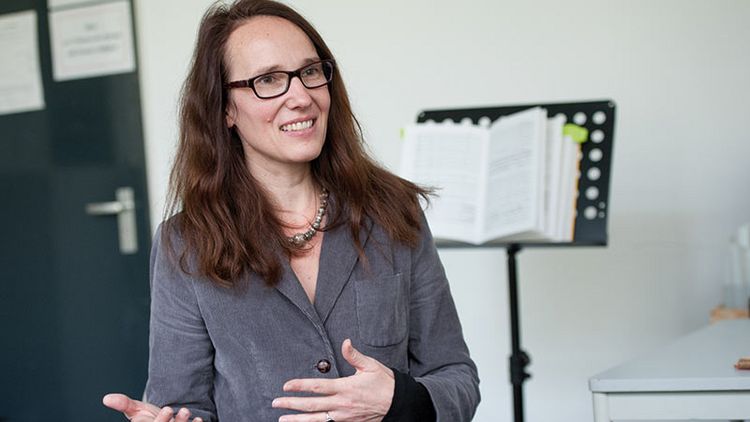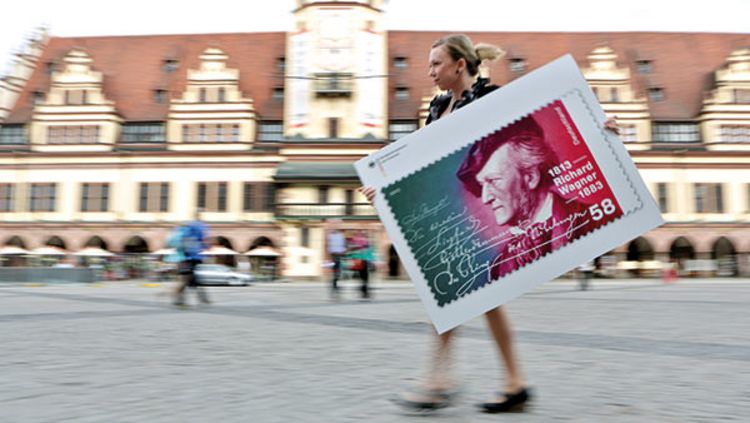Two hundred years of Wagner and no end in sight: festivals and ceremonies, productions, concerts, interpretations, documentations and tributes abound. And yet by no means has the subject been exhausted. Melanie Unseld talks in an interview about gender constructions, self-promotion, love, opera and pop music.
Mrs. Unseld, it‘s the Richard Wagner bicentenary, and lots of the big opera houses have programmed new productions of “The Ring”, which all sold out immediately. The feuilletons are thrilled. What is so fascinating about Wagner?
UNSELD: The music, for one thing. Wagner‘s music is incredibly absorbing. You don‘t have to look far into the reception of Wagner to see how many people have been and still are quite simply spellbound by his music. In France, Richard Wagner prompted an entire aesthetic movement, known as Wagnérisme. Then, of course, people are also fascinated by Wagner, the artist.
This fascination has obviously not decreased over time. What is the current Wagner year about? Is it just PR to sell new books on Wagner and new productions of his works?
UNSELD: Anniversaries always express particular commemorative cultures. They tell us a great deal about our own cultural identity. How many composers have the privilege or misfortune – depending on your point of view – to be celebrated with an anniversary year? It‘s no more than a handful, and this selection speaks volumes about us, or more precisely, about our musical canon. But no composer is included in the canon without considerable support. Wagner was a child of the 19th century and he was very aware that this canon was crucial to him and the survival of his work. He therefore worked extremely hard to get into the canon and just as hard to stay there, and as a result we almost take it for granted that his 200th birthday will be celebrated as a grand occasion.
How did Wagner achieve this – aside from composing?
UNSELD: He was a prolific writer, not just on music but also on aesthetics. And he turned Bayreuth into a place dedicated exclusively to performances of his musical dramas. Did any other composer do anything like that? And, of course, in Cosima Wagner he had a woman at his side who laid the groundwork for the survival of his works as his chronicler and his administrator after his death.
Wagner also dictated his autobiography to her.
UNSELD: Yes. This, however, was a most peculiar situation. On the one hand, Richard Wagner dictated his autobiography to his second wife Cosima. On the other, Cosima Wagner regarded herself as his chronicler rather than merely his secretary. This meant she also had a hand in shaping his autobiography as it was written.
In other words, she was instrumental in shaping the image we have of Wagner today?
UNSELD: Yes. A lot of what we know about Wagner we know from her notes, the autobiography and even more so from her diaries. Her perspective, in other words, played a key role. And as the documents show, the two of them were very much involved in debates on artist heroism, and this certainly shows in her notes. Both of them, for example, read and reread Thomas Carlyle many times.
A British author and essayist who was known as one of the pioneers of heroism in the 19th century.
UNSELD: Cosima and Richard Wagner were convinced that the image of the artist as a hero could only be realized through the constellation in which Richard Wagner plays the role of the genius composer, with Cosima Wagner in the role of his chronicler. The two of them made a conscious decision to create Wagner‘s image in this way.
Wagner, the hero, the heroic artist. But his operas were certainly not lacking in heroic figures either. Are these the kind of standard opinions that you question in your research?
UNSELD: Particularly in the Wagner year I want to show that there are aspects of Wagner research that have escaped attention until now but which are nevertheless critically important.
The gender research in the field of musicology has tended to keep away from Wagner?
UNSELD: There has been comparatively little focus on Wagner in this field. What interests me is why. Is Wagner too obvious a research subject, because his work is always about “the woman” (“Weib”) and “the hero” (“Held”)? Or are there other reasons? Wagner lived in a time of a rigid dichotomy of the sexes, a heteronormativity that seems to be clearly reflected in the woman–hero formula. He himself spent a lot of time thinking and writing about sex, gender and the relationship between woman and man. But the unambiguousness of heteronormativity breaks down in numerous places both in his theoretical writing and in his stage works. These ruptures are worth examining in more detail. Even researchers clung to this dichotomy in their reception of Wagner‘s work for a long time, without drawing any distinctions. This is also worth thinking about in more depth.
Let‘s pin this to a specific example. On the one side we have Siegfried the dazzling, manly hero...
UNSELD: The key factor is his portrayal as manly hero – how often have we seen Siegfried in a bearskin! Take, for example, the exhibition of pictures of Wagner productions at the beginning of the 20th century in the New York Metropolitan Opera– it‘s an endless collection of bearskins, horn helmets and spears. But the fascinating thing is that the exhibition clearly shows staging patterns which, on the one hand, were strongly influenced by the stagings during Wagner‘s lifetime. On the other hand, it visually reinforces the old dichotomy between man and woman, and at a time when women were protesting on the streets for their right to vote. It is also interesting that while the productions were disambiguating heteronormativity, the scores, the texts, and Wagner‘s own writings offered a good deal of friction to this model. There are also plenty of questions about the “hero” concept peeking out from behind the bearskin...
Is “Tristan and Isolde” a good example of this? The fascinating thing about “Tristan” is that here Wagner approaches the concept of “the couple” in a completely different way.
UNSELD: First of all, there is a triangular constellation which creates this drama. But basically it is a confrontation between two different concepts of “the couple” – King Marke and Isolde – and the “actual” couple – Tristan and Isolde. It seems to me that this aspect of all the things that are key to the long tradition of motifs in the medieval subject matter was what really interested Wagner. We should bear in mind that the dominant concept of “the couple” at the time when “Tristan” was written was middle-class marriage. To break out of marriage, to throw it into question – as Tristan and Isolde do – points to a “sore point” in society. To this extent Wagner‘s “Tristan” offers up the concept of marriage for discussion. Another interesting point is that Utopia is the only place he finds for Tristan and Isolde‘s love.
And then on the other hand you have the opera “Lohengrin” with the character of Elsa, whom Wagner regarded as the prototype of what he called the „Weib“, or „the woman“.
UNSELD: Elsa was the archetypal woman for Wagner – this is how he described her. This archetypal woman is reliant on being saved by the knight in shining armour. This moment of the woman‘s salvation by the hero is central to Wagner.
But here, too, Wagner explores the principle of partnership – just like in “Tristan”.
UNSELD: Wagner does fall back on the same model. However, in “Lohengrin” it works differently: had Elsa not asked Lohengrin who he was and where he came from, things would have worked out for the two of them, and they would have been married...
So “Lohengrin” is also about the failure of the middle-class notion of marriage and partnership.
UNSELD: Yes, but in a way that is more in keeping with the 19th century dichotomy of the sexes. Remember, Lohengrin is the bearer of a secret. Elsa is not allowed to ask about it. She has to remain ignorant. If she knew his secret, if she knew about his true identity, it would give her equal status in a way. And the 19th century middle-class concept of marriage was anything but a marriage of equals. It is a clearly defined model of dependency, emotional as well as legal and social dependency. And this relationship of dependency is challenged by Elsa‘s question – and the couple‘s relationship ends.
How much of Wagner‘s own life is reflected here? He did, after all, have numerous amorous liaisons alongside his two marriages.
UNSELD: We have to be careful here. Are we able to directly see into Wagner‘s life? Or is what we see really just what was written about Wagner‘s life? Wagner himself, as I mentioned, strongly influenced his image as artist in various media. One aspect of this was the image of the genius who needs a muse for inspiration, as well as that of the revolutionary, the visionary. We should try not to be mislead by the way he portrayed himself and others portrayed him.
This playing with identity and the creation of an artistic persona all seems so modern – the norm in popular culture today.
UNSELD: Wagner and popular culture are no antitheses. On the contrary, even Carlyle‘s concept dealt with greatness and popularity, or popularity through greatness. For Carlyle, the hero is always also a man who is visible in society and publicly celebrated. Things also get interesting when Wagner and popular culture meet. For example, we can no longer hear the “Ride of the Valkyries” without thinking of “Apocalypse Now”. By the way, in this scene Francis Ford Coppola also stages a sort of heroism, one of a completely broken nature. It is areas like these that Wagner research needs to explore. It‘s not about showing that Siegfried is a dazzling hero, that Elsa is the archetypal woman; it‘s about nuances, the frictions which Wagner worked into the concept of hero and woman. I am convinced that these nuances and distinctions hold the key to Wagner‘s enduring popularity.
Prof. Dr. Melanie Unseld has been teaching the cultural history of music at Oldenburg University since 2008. Since 2009 she is head of the Center for Interdisciplinary Research on Women und Gender. She studied historical musicology, literary studies, philosophy and applied cultural sciences in Karlsruhe and Hamburg. In 1999, she earned her doctorate at the University of Hamburg with a paper on death and femininity in the music of the late nineteenth and early twentieth century. Unseld is co-editor of the „Europäische Komponistinnen“ series published by Böhlau and of the „Lexikon Musik und Gender“ published by Bärenreiter and editor of the Reclams Komponistenlexicon.


